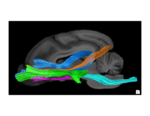Researchers at the Cornell University College of Veterinary Medicine have provided the first documentation that dogs’ sense of smell is integrated with their vision and other unique parts of the brain, shedding new light on how dogs experience and navigate the world.
“We’ve never seen this connection between the nose and the occipital lobe, functionally the visual cortex in dogs, in any species,” said Dr. Pip Johnson, assistant professor of clinical sciences and senior author of “Extensive Connections of the Canine Olfactory Pathway Revealed by Tractography and Dissection.”

Sagittal brain image generated using TrackVis software. Courtesy of Dr. Pip Johnson/Cornell University College of Veterinary Medicine. Copyright: CVM Marketing and Communications
“When we walk into a room, we primarily use our vision to work out where the door is, who’s in the room, where the table is,” she said. “Whereas in dogs, this study shows that olfaction is really integrated with vision in terms of how they learn about their environment and orient themselves in it.”
Johnson and her team found connections where the brain processes memory and emotion, which are similar to those in humans, as well as never-documented connections to the spinal cord and the occipital lobe that are not found in humans.
The research corroborates her clinical experiences with blind dogs, who function remarkably well. “They can still play fetch and navigate their surroundings much better than humans with the same condition,” Johnson said. “Knowing there’s that information freeway going between those two areas could be hugely comforting to owners of dogs with incurable eye diseases.”
Identifying new connections in the brain also opens up new lines of questioning. “To see this variation in the brain allows us to see what’s possible in the mammalian brain and to wonder – maybe we have a vestigial connection between those two areas from when we were more ape-like and scent-oriented, or maybe other species have significant variations that we haven’t explored,” Johnson said.
For more information, see this Cornell Chronicle story.
Source: Cornell press release

